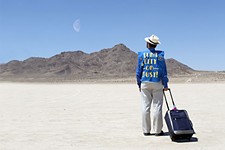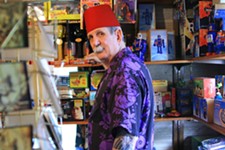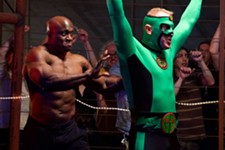Flowing Over
More with Craig Brewer
By Marc Savlov, Fri., July 22, 2005
Austin Chronicle: How old were you when you got into hip-hop? Was that your formative musical experience?
Craig Brewer: I've never said this in print, but here's the three things in my life that I think helped make me who I am: I remember watching Michael Jackson moonwalk for the first time on the Motown [television] special and staying up all night long with my dad trying to learn how to moonwalk. We were in our kitchen, with the linoleum floors, shoes off, and I would rewind the Betamax, play it, rewind it again, and try to learn how to moonwalk.
The second formative moment was when I saw Herbie Hancock's "Rockit" video for the first time. I taped it and I would just play it over and over again. Even today I think that video could hold its own. It's like something you would see in a Beck video and it's the first time I ever saw or heard scratching, you know? So, suddenly, all my friends are trying to learn how to scratch [records].
And then the third thing was Apollonia's breasts in Purple Rain. I'm 33 now, so I must have been in grade school back then, and I got so into Purple Rain, I mean, it was a big deal in my life. I think I fell in lust with Apollonia.
Back in those times, it was really exciting to start getting into the early hip-hop and rap, because it wasn't as segregated as it is today. Radio stations would play Doug E. Fresh and Run DMC alongside the Eurhythmics and Billy Joel. It's almost like there were radio stations for young people and then radio stations for old people, and there was no delineation between the two. And interestingly, a lot of the music producers that are big and hot right now, they exist off that same thing. They aren't necessarily drawing their influences from rap and hip-hop, they're drawing them from everywhere. So, you can get tribute song to Biggie by Puff that's sampling "Every Breath You Take." And it works.
I think that my age group is kind of an interesting group of people, because we were around when hip-hop and rap first started getting big. And in Hustle & Flow, I put these references that I know young people may not know or remember, because the film is really about guys in their 30s who know hip-hop is a young man's game, but also feel the need to do something with their skills and their love of the game. For instance, there's a mention of the Fat Boys, and I don't even know if anyone remembers the Fat Boys today, but I do, you know?
AC: So it was straight into hip-hop for you? No detour into punk rock?
CB: For me, spending my summers with my dad in Memphis, he was infusing me with a lot of soul, Sam and Dave, Otis Redding, and it was all about the blues. My Aunt Mary Jean would take me down to Beale Street, and that's when I started buying my first blues albums. I remember the blues that really affected me all relate to movies and sex. In Risky Business – another pimp movie – where Tom Cruise is putting on his black sunglasses and he's going around trying to get everybody to come to his party, on the soundtrack they're playing Muddy Waters' "Mannish Boy." And I got really into that song. Another one I was really into was Prince's "D.M.S.R.": "Dance, Music, Sex, Romance." And I found that those two songs were a lot alike, very repetitive with this sexual feel that just went on and on and on. That's when I really started getting into the blues. I kind of skipped over punk entirely. When I moved back to Memphis for good about 11 years ago, that's when I really started getting into the Memphis "Dirty South" rap, and I mean the underground shit, like Al Kapone, early Pastor Troy, Eightball and MJG, Joe Gotti, Tommy Wright III, and 36 Mafia. The more I got to know them, the more I realized how much I had in common with them. I know that sounds strange, but I actually had a lot in common with them because my wife and I lived kind of this interesting life in Memphis for a while, where I worked at a bookstore and she was a seamstress who worked nights as a stripper while I worked in this bar called the P and H Café. We were also trying to make movies on DV, cutting them on our computer, and building sets in our house, which was a shitty little place just like DJay has in Hustle & Flow. And listening to all these Memphis rappers I realized they were doing the exact same thing I was, only with hip hop. They would write about things in their lives that, while not necessarily proud of them, they were real-life events. And then they'd lay down these tracks in a really guerrilla way, recording them in their kitchens or closets with an MPC borrowed from someone and a keyboard borrowed from someone else. It kind of reminded me of everything I'd read about Stax Records, how they had turned an old theater into a very down and dirty recording studio with this great raw sound. Everything we were doing and listening to seemed to have a uniquely Memphis tradition.
AC: How did your interest in hip-hop segue into the making of Hustle & Flow? Did you go to film school at some point?
CB: I had completed one film, called The Poor & Hungry, which debuted in Austin at the Austin Film Festival back in 2000. Austin, by the way, has a very interesting relation to Hustle & Flow because as I was driving down to go to the AFF, I began carding – that's like film outline with different scenes written on index cards – Hustle & Flow. So, Hustle & Flow is essentially the story of me and my wife trying to make The Poor & Hungry. My father and I were very close, and he produced the plays that I would write while I was in high school even though he was in shipping and had nothing to do with theatre or film. When he read the script for The Poor & Hungry, he told me I should shoot it on video, on DV – and this is before The Blair Witch Project and all that – and then died suddenly. In fact, he died that same day. And the last thing he told me was "Don't apologize for not having money, celebrate it." And so, with the $20,000 of inheritance that I got from my dad's passing, I went out and bought a DV camera and some equipment and began to learn the specifics of how to shoot a film. And that was my film school.
AC: When you say film school, you mean what? Reading books on filmmaking?
CB: Yeah, and magazines. And then what I started trying to do was to produce as many of my friend's projects as I could. One of them was a good filmmaker who I'm still really good friends with by the name of John Michael McCarthy. He makes these movies with, like, topless girls with beehives and machine guns – I love it! – and he's got this great Russ Meyer sensibility. And that's when I started shooting The Poor & Hungry. I had a crew of two: me and my brother-in-law. He held the boom and I held the camera, and we made our own lights out of plywood and photoflood bulbs.
AC: Totally DIY …
CB: Absolutely. I remember I was at this cheap motel that I rented for an hour to shoot a scene in and this pimp rolled up on me. He had this white hooker with microbraids in her hair and he was trying to sell her to me while she said nothing and just looked at me bored out of her gourd and covered in sweat. And that's when I started getting the idea for Hustle & Flow. Who are these people? What do they talk about when she's not turning tricks? What if that guy had the same kind of life crisis I had? When your dad dies at 49, you begin to think your own life's half-over at 24.
AC: When did John Singleton come on board Hustle & Flow?
CB: I went around Hollywood for a year to two years with my producer Stephanie Allain, and every studio either said no or 'Don't cast Terrence Howard,' or 'Craig, you can't do it because you're white.' And, finally, Stephanie decided that since I'd made a good movie for 20 grand, then maybe I could do a good one for 500 grand. So, she sold her house and put up half of that. Stephanie, by the way, gave Singleton his start when she was at Columbia – she green-lighted Boyz-N-the Hood – and sent the Hustle & Flow script to him to see if he would maybe come in on the other half of financing. Turns out he thought the script was great and said "Let's do it for 10 million. You just need me in the room." And so we went to every studio again, with Singleton with us, and they still all said no. I think that pissed John off, that made him feel they were disrespecting him, personally, because here he had just made 300 million dollars for Universal Studios on 2 Fast 2 Furious. It was a big-titted success. I mean, it was huge. And no on would even give four million dollars to make Hustle & Flow, even though we already had Ludicris and Anthony Anderson attached. And rightly, John felt insulted. He ended up putting his house up for collateral and financed the film himself.
The prevailing myth in Hollywood is that if you make a big movie that makes lots of money, then the studios will let you do whatever you want. And that's just bullshit.
That's why I get pissed off when people say [about Hustle & Flow] that I'm doing a stereotype. Bullshit! I fought Hollywood not to do a stereotype! I could have gotten this movie green-lit a lot sooner if I'd just made fun of the pimp character, or if I got Chris Tucker to play him in silks and Kangols. But I really wanted to represent these people that I know, the hustlers that're moving girls from shake joint to shake joint.
AC: Terrence Howard, who plays DJay the pimp, is a fantastic rapper in the film. Had he done that before or is he just that good an actor?
CB: Terrence Howard is a musician and singer who hates rap. It was hard to get him to let go of some of that anti-rap bias, but what was fortunate for us was that because he's so musical, he kind of learned about DJay from the outside in. I remember DJ Paul from 36 Mafia, told us "You know, we don't have any talent. We just talk. We don't have any talent." And I just kept telling Terrence that, hey, DJay only has what he has. He's not as talented as Terrence Howard, he's not as intelligent as Terrence Howard, he only has this gift of gab where he's been talking people into buying his stuff all of his life. And that is what he's trying to parlay into art. And once Terrence got that, the character just came to life immediately.
AC: Your next film, Black Snake Moan, with Samuel L. Jackson and Christina Ricci, isn't going to be nearly as indie as your first two films, seeing as how Paramount Classics is producing it. Are you worried about losing something in the mix once you go from DIY guerilla to studio-backed filmmaker?
CB: You know, I'm not. We have the same team – Stephanie and John – and Brad Grey and everybody at the studio has been very supportive of our vision, and I think they're going to let us make the movie we want to make. And it's a good one. ![]()
Hustle & Flow opens in Austin on Friday, July 22. For a review and show times, see Film Listings.










